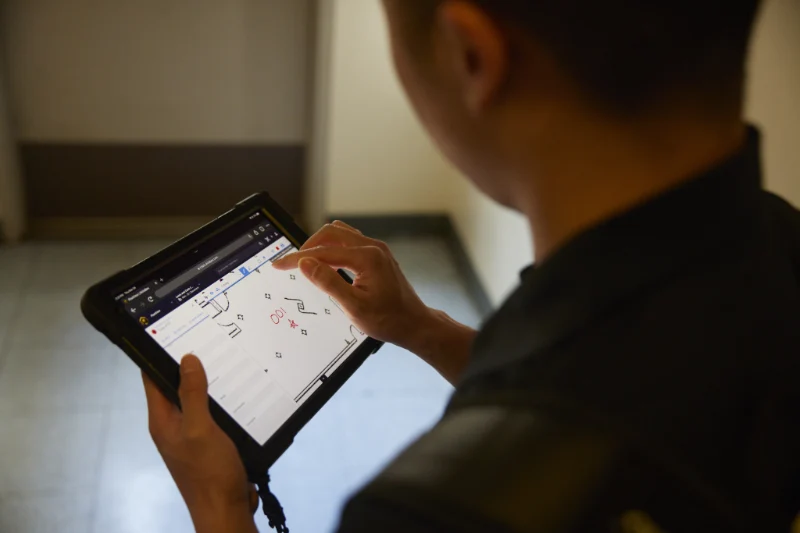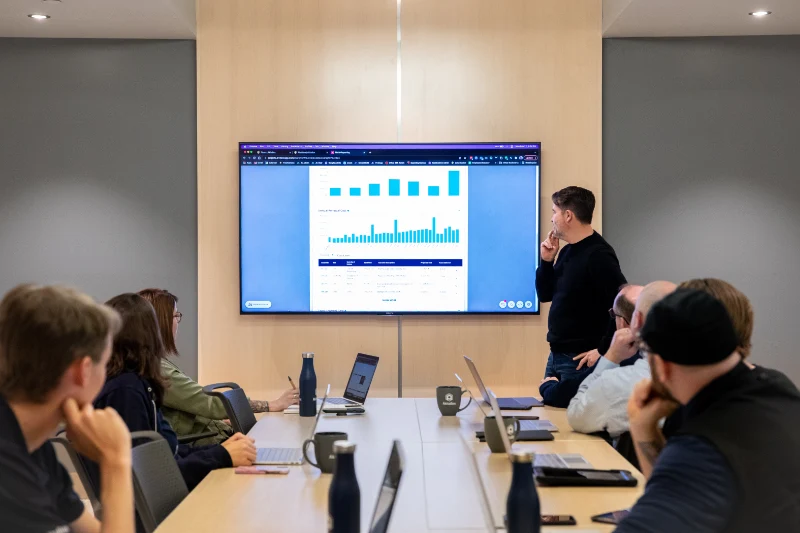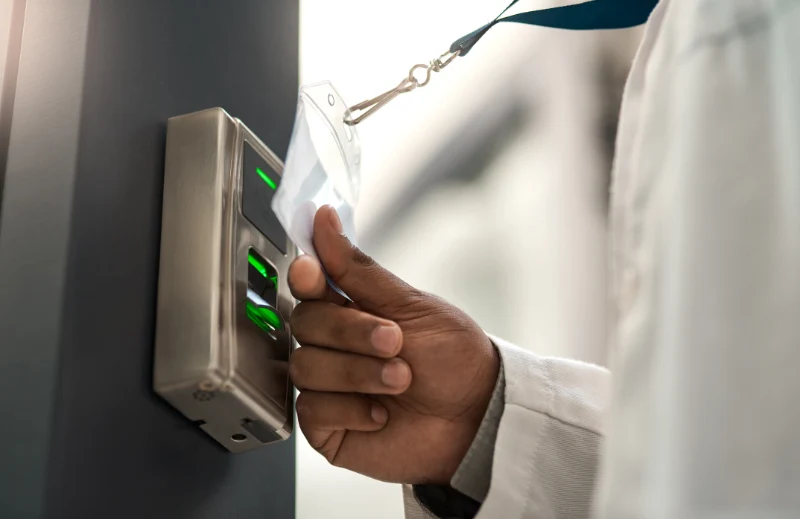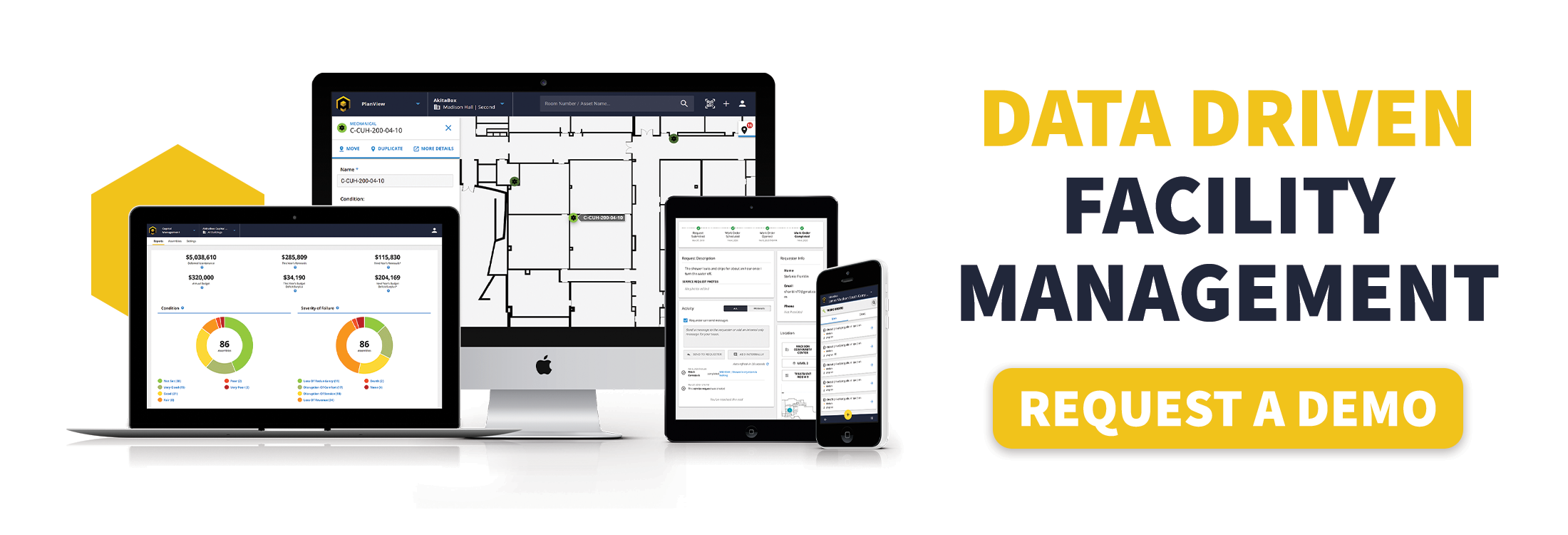15 Types of Building Management Software (and Which One You Should Use)
Trying to figure out what facility software you need? You’ve come to the right place. Thanks to the continued march of technological advancement, you have more options than ever before.
Which type (or types) of software you should use depends on what you want to accomplish. For example, if you’re looking for a way to measure occupancy, capital planning software probably isn’t the right solution for you.
Some types of software are multi-purpose and can do a variety of actions within the same system, while others are highly specialized. So depending on what your requirements are, you might only need one software or you may need to invest in multiple software tools.
Let’s explore 15 of the most common types of building management software, including what they do and how they can help you meet your goals.
Types of Facility Software
What is CMMS?
What is CAFM?
What is IWMS?
What is EAM?
What is facility optimization software?
What is BAS?
What is EMS?
What is capital planning software?
What is assessment software?
What is inspection software?
What is space and move management software?
What is EHS?
What is access control software?
What is VMS?
What is emergency management software?
1. Computerized Maintenance Management System (CMMS)
CMMS is typically used by maintenance technicians, managers, custodial workers, and other facilities personnel to manage maintenance and repair programs. An organization might use a CMMS to triage service requests, track work orders, manage asset information and costs, schedule preventive maintenance tasks, organize documentation, and more.
What CMMS Does
- Maintenance management
- Preventive maintenance
- Work orders
CMMS Benefits
A CMMS is a great option for small organizations that are looking to save time, improve efficiency, and lower costs in order to improve the bottom line. Use it if you’re looking for a cheaper software solution to help you better manage buildings, spaces, equipment, and assets. Most CMMS options on the market today are cloud-based, which means your solution won’t require manual updates year-round.
Examples of CMMS Software:
- AkitaBox Platform
- ARC Facilities
- AssetWorks
- Eagle CMMS
- Eptura (formerly Hippo CMMS)
- Fiix
- FSI (for healthcare)
- Limble
- Maximo
- Soleran (for healthcare)
- TMA Systems
- UpKeep
2. Computer-Aided Facility Management (CAFM) Software
CAFM software is a relatively comprehensive solution, designed for managing spaces and the assets they contain. In addition to asset and maintenance management, CAFM software focuses on optimizing space and occupancy needs, including capacity planning, visitor management, access control, room reservations, safety, and energy usage.
What CAFM Does
- Asset management
- Maintenance management
- Space optimization
- Capacity planning
- Visitor management
- Access control
- Room reservations
- Safety
- Energy usage
CAFM Benefits
CAFM software is a good option for operations teams looking to optimize the management and utilization of spaces within their buildings, and get a bigger picture of what’s happening throughout their properties. Many of today’s CAFM software solutions can integrate facility management and corporate real estate processes into a single solution.
Another benefit of CAFM software is the ability to integrate CAD drawings with space management and layout planning. It might be a good fit for you if you’re looking to improve your long-term planning of maintenance, space, facilities, and budgets to ensure optimal alignment with business needs.
Examples of CAFM Software:
- Accruent
- AkitaBox
- Archibus
- Eptura (formerly Space IQ)
- FM:Systems
- OfficeSpace
- iOFFICE
- Planon
- TRIRIGA
3. Integrated Workplace Management System (IWMS)
IWMS is a software platform that helps an organization optimize workplace resources. It can be used to manage an organization’s real estate portfolio, infrastructure, and facilities assets. IWMS serves as a single solution for scheduling maintenance, tracking capital projects, and reducing energy use.
What IWMS Does
- Maintenance management
- Capital project management
- Real estate lifecycle management
- Resource management
IWMS Benefits
As a whole, IWMS software is used to maximize the usefulness of an organization’s resources and assets, all within a single software platform where information can be shared among stakeholders. You might benefit from using IWMS software if your organization needs a platform and database repository to manage any (or all) of the following areas:
- Real estate
- Leasing
- Space
- Assets & maintenance
- Projects
- Environmental sustainability
Examples of IWMS Software:
- AkitaBox Pulse
- ARC Facilities
- Archibus
- Brightly (formerly Dude Solutions)
- FacilityONE
- FMS: Workplace
- iOFFICE
- Nuvolo
- Planon
- TRIRIGA

4. Enterprise Asset Management (EAM) Software
As the name suggests, EAM software is all about assets. It’s designed to help organizations manage, maintain, and optimize their physical assets throughout their lifecycle – from acquisition to disposal. From procurement, to inventory management, to maintenance, to safety and compliance, EAM software is a comprehensive solution for all things asset management.
What EAM Does
- Asset management
- Maintenance management
- Procurement
- Inventory
- Safety & compliance
EAM Benefits
EAM software’s purpose is to manage the entire lifecycle of physical assets and equipment in order to maximize their useful life, reduce costs, improve quality, and promote efficiency. Use an EAM system if your organization wants to integrate maintenance activity information with associated labor, inventory, materials, tools, and other information from facilities and other departments.
Examples of EAM Software:
5. Facility Optimization Software
Facility optimization software offers all the capabilities of a typical CMMS (asset and maintenance management), but also incorporates additional applications for capital planning, assessments, and inspections and compliance.
It’s a holistic solution that focuses on collecting, storing, and analyzing the massive amounts of data generated by a building throughout its lifecycle in order to give you a clear overall picture of a facility’s current performance and areas for improvement.

Insider Insight
“Compared to a typical CMMS solution, facility optimization software offers more widespread value to an organization and its users. CMMS solutions typically focus on the maintenance side of the house, offering features and functions that help manage day-to-day maintenance and facility needs.
Facility optimization software, like AkitaBox, extends far beyond facilities departments by not only supporting maintenance needs and improving operational efficiency, but also improving overall compliance posture, asset management, capital funds budgeting, and more. Building infrastructure platforms contribute to the success of an entire organization, from boiler room to boardroom.”
Geoffrey Baron • Product Manager at AkitaBox
What Facility Optimization Software Does
- Asset management
- Maintenance management
- Capital planning
- Inspections
- Construction handover
- Assessments, including:
- Facility condition assessments
- Property condition assessments
- Asset inventory
- Energy audits
- Lighting audits
- Technology audits
- Fire-Life-Safety audits
- And more
Facility Optimization Software Benefits
Facility optimization software supports the complete lifecycle of a building. It facilitates the transfer of valuable data from the building’s construction into a format the maintenance team can use starting day one of operations. (AkitaBox Connect is an example of this component of facility optimization software).
From there, the software allows you to manage the complete operational needs of the building in one platform:
- Work orders
- Preventive maintenance
- Asset management
- Capital planning
- Assessments
- Inspections & compliance
In addition, it organizes the data from your assets into an easily-accessible format that gives you a 10,000-foot view of how your facilities are performing with the ability to drill down into specific details. This empowers you to make data-driven decisions on everything from labor distribution, to asset replacements, to capital expenditures.
A facility optimization platform helps your organization safeguard operations, reduce deferred maintenance, meet regulatory compliance requirements, and make smarter business decisions throughout the lifecycle of the facility. In other words, it helps you optimize every aspect of your facilities management so it performs at its best every day.
At the end of a building’s life, all of the operational data collected within the software can provide valuable insights as the next building is designed and built – kicking off the lifecycle of a new facility.
Examples of Facility Optimization Software:
6. Building Automation Systems (BAS)
A Building Automation System (BAS) is a network of interconnected devices and software designed to automate and control various building functions, such as HVAC, lighting, security systems, fire safety systems, and access control. It integrates these multiple different systems under one set of controls so they can be more easily managed from a central location.
As a simple example, the BAS can identify that the air temperature in a building has fallen below the desired level and turn on the heat to warm up the building.
What BAS Does
- HVAC control
- Lighting control
- Security system control
- Fire safety system control
- Access control
BAS Benefits
By automating processes, a BAS can enhance a building’s efficiency, safety, comfort, and security, leading to:
- Energy savings
- Enhanced comfort for building occupants
- Improved building safety and security
- Easier maintenance
- Reduced operational costs
In addition, a BAS frees up valuable time for facilities technicians so they can focus on issues requiring direct, hands-on attention.
Examples of BAS:
7. Energy Management System (EMS)
An Energy Management System (EMS) monitors, controls, and optimizes energy use in buildings. By collecting and analyzing data in real time, it can dynamically control energy flow, thereby lowering energy costs and emissions.
What EMS Does
- Energy management
EMS Benefits
An EMS can track energy consumption, identify areas for improvement, set energy-saving goals, and manage energy use in real-time. As a result, organizations that use an EMS can:
- Gain greater visibility and transparency into current energy consumption
- Reduce energy costs by optimizing consumption at the asset level
- Lower carbon emissions and reduce reliance on fossil fuel-based power sources
- Comply with energy regulations
What’s the difference between BAS and EMS?
You may hear the two terms used interchangeably, but BAS and EMS serve different functions.
A BAS (as described in the previous section) automates HVAC controls, lighting, access control, alarm systems, security cameras, and other systems. Although it indirectly affects energy usage by controlling HVAC and lighting systems, its main function is to improve overall building management.
An EMS directly manages energy use to improve efficiency and reduce costs. It can include energy monitoring, analysis, planning, and control to optimize energy consumption and may have features for integrating renewable energy sources or managing energy storage.
In summary, a BAS is primarily about automating building functions for improved management, while an EMS is focused on optimizing energy use for efficiency and sustainability.
However, as today’s BAS and EMS systems continue integrating features from each other, they’re becoming much more similar to one another as far as functionality. But they can still differ in terms of cost and return on investment.
Examples of EMS:
8. Capital Planning Software
Capital planning software is a specialized tool for planning, budgeting, and managing long-term facility investments and projects – from replacing a boiler to remodeling an entire building. It’s instrumental in organizing, analyzing, and forecasting financial expenditures.
What Capital Planning Software Does
- Cost estimation
- Budgeting
- Short-term and long-term financial planning
Benefits of Capital Planning Software
Software designed for capital planning and budgeting has a distinct edge over tools like spreadsheets.
Efficient budgeting and cost management: Robust budgeting and forecasting tools estimate costs and allocate funds accurately. Stay within budget, avoid unexpected costs, and ensure efficient use of financial resources.
Data-driven decision-making: With analytical tools and reporting features, evaluate projects based on return on investment, risk assessment, and other relevant metrics, leading to better prioritization and resource allocation.
Reporting and analytics: Track project progress, compare budgets to actuals, and generate customized reports for stakeholders.
Risk mitigation: Identify potential risks early and take appropriate action.
Prioritization and decision support: Evaluate and prioritize capital projects based on various criteria, such as return on investment, risk assessment, and alignment with strategic goals. This assists decision-makers in selecting projects that align with the organization’s objectives.
Capital planning software is often used with general building management software like CMMS. This combination facilitates data sharing and enhances operational efficiency.
A facility optimization software system like AkitaBox includes integrated capital planning software that analyzes the asset and maintenance data from a building to identify key areas for investment, prioritize spending needs, and run various budget scenarios.
Examples of Capital Planning Software:
9. Assessment Software
Whether a facility condition assessment, property condition assessment, energy audit, or asset inventory, assessments are an important part of facilities management. Assessment software is a valuable tool for evaluating the performance, functionality, and condition of physical assets.
There are many types of assessment software, some with multiple functionalities that can be used for comprehensive facility assessments and others focused on more specific types of assessments, such as safety, compliance, infrastructure, or preventive maintenance.
Assessment software typically includes components for data collection, analysis, reporting, and collaboration.
What Assessment Software Does
- Facility condition assessments
- Property condition assessments
- Asset inventory
- Energy audits
- Technology audits
- Fire-Life-Safety audits
- Inspections
Benefits of Assessment Software
Assessment software makes the entire process more efficient and eliminates the need for outdated, error-prone methods like pencil and paper or spreadsheets. Using software designed for assessments offers:
- Standardized processes
- Fewer errors and discrepancies
- Enhanced collaboration, communication, and visibility
- Seamless data transfer between the various stages of an assessment
Living FCAs: The Ultimate Assessment
The traditional facility condition assessment (FCA) has historically been the gold standard of assessments because it delivers a complete snapshot of the current condition of all of your assets – giving you the necessary data to make important spending and management decisions.
However, a static snapshot of information goes out of date quickly. Enter the living FCA – an assessment that’s constantly fed with fresh data from your facility management software. It’s an always-current view of your assets’ condition and performance that never gets stale.
Living FCAs are possible in situations where assessment software and facilities management software are part of the same integrated system. AkitaBox is one example of this kind of platform.
Read More: One Tool to Do It All: A New Era in Facility Assessments
Examples of Assessment Software:
- AkitaBox FCA (for living FCAs)
- FMX
- Intellis
- Origin by Brightly
- Paragon
- Sitemate
- VFA

10. Inspection Software
Whether your organization needs to comply with OSHA, the Joint Commission, or any number of other regulatory agencies, inspection software streamlines and simplifies the process of ensuring your assets are performing properly and safely.
Paper checklists and floor plans make regular inspections time-consuming and error-prone. Inspection software:
- Increases employee safety
- Captures digital records of inspections
- Ensures compliance with safety and health standards, as well as federal, local, and industry-specific requirements
Depending on which type you use, it can be a standalone software or a component of a complete facilities management platform.
What Inspection Software Does
- Safety and compliance audits
- Asset condition analysis
Benefits of Inspection Software
- Create easy-to-follow checklists and routes
- Track that all inspections have been completed
- Create and assign work orders for any assets that fail inspection
- Prove you’re in compliance
Additionally, inspection software makes it easy to produce all of your inspection results and resolution actions taken when regulatory agencies demand them. Because even the most robust compliance program in the world won’t help you if your regulatory assessor can’t access the information they need.
Examples of Inspection Software:
11. Space and Move Management Software
Handling space use and moves within your facility typically go hand-in-hand. Most software in this niche includes functionality for both.
The space management component is all about managing, tracking, and optimizing the use of physical spaces in buildings and on campuses. It allows facilities professionals to visualize and oversee the layout and allocation of space.
You can create floor plans, manage room reservations and seating arrangements, and get real-time tracking of metrics such as occupancy rates and space use patterns. This software is useful for making decisions about your facilities’ space needs and ensuring you’re using your existing space as efficiently as possible.
The move management component does just that – it assists in planning and executing relocations within a facility. This could be moving individuals, teams, or entire departments. The software helps coordinate the logistics of the move to minimize disruption and downtime.
What Space and Move Management Software Does
- Space optimization
- Room reservations
- Seating arrangements
- Occupancy tracking
- Relocation planning
Benefits of Space and Move Management Software
Using software to administer space can save costs and improve occupant satisfaction. By optimizing space use, organizations can reduce spending associated with underutilized spaces or excessive real estate holdings and identify opportunities for consolidation.
Effective space management also contributes to a better workplace environment where everyone has the space they need to do their jobs and collaborate with colleagues while maintaining compliance with health and safety regulations.
Examples of Space and Move Management Software:
- AkitaBox
- Eptura (formerly Space IQ)
- OfficeSpace
- Tango
- TRIRIGA
- Wisp by Gensler
12. Environmental, Health, and Safety (EHS) Software
Manage all of your health and safety programs in one place.
What EHS Software Does
- Compliance management: automates the process of keeping up with regulatory changes and ensures the business is compliant with environment, health, and safety rules through audits, reports, and documentation control.
- Risk assessment: identifies, assesses, and manages risks associated with workplace and environmental hazards and helps determine appropriate mitigation strategies.
- Incident management: records, tracks, and manages health and safety incidents (including accidents, injuries, illnesses, near misses, and non-compliance situations) and analyzes them to prevent future occurrences.
- Training: provides safety training for employees and ensures all personnel are up-to-date on any necessary training or certifications.
- Sustainability management: tracks metrics such as carbon footprint, waste management, and resource consumption to support sustainability efforts.
Benefits of EHS Software
By bringing all of your environmental, health, and safety activities under one software umbrella, you can:
- Reduce the risk of legal penalties and fines related to regulatory compliance
- Reduce and even prevent workplace injuries and illnesses
- Automate and streamline time-consuming administrative tasks
- Make informed, data-backed decisions that can improve your environmental performance and safety standards
- Meet your corporate social responsibility objectives
Examples of Space and Move Management Software:

13. Access Control Software
Access control software is a critical component of a building’s security system. It ensures that only authorized individuals have access to restricted or sensitive areas.
Building occupants use credentials such as electronic keys, biometric data (like fingerprints or facial recognition), or PIN codes that the software verifies to determine if that individual is allowed to access a particular area. If the credential is verified, the software can unlock the door (or keep the door locked if the credential isn’t verified).
What Access Control Software Does
- Allows access to authorized users
- Restricts access by unauthorized users
- Tracks all entrances and exits
Benefits of Access Control Software
Using software to manage access instead of old fashioned metal keys and locks provides a number of advantages:
Access rules and policies: set up specific rules for who can access certain areas and at what times.
Real-time monitoring and logs: tracks who enters and exits specific locations and at what times, which is crucial for security audits and investigations.
Remote access management: grant or revoke access from anywhere, which is particularly useful for managing multiple buildings or emergency situations.
Integration: software can integrate with other security systems such as video surveillance, alarm systems, and visitor management systems to provide a comprehensive security solution.
Enhanced security: significantly reduces the risk of unauthorized entry, theft, or breaches of sensitive areas.
Convenience: credentials can be easily issued, modified, or revoked without the need to physically change locks or collect keys.
Examples of Access Control Software:
14. Visitor Management System (VMS)
Instead of having guests sign in on a paper log book, a visitor management system provides a faster, more secure way to ensure visitors have the facility access they need while keeping building occupants safe.
A typical VMS allows guests to sign in using a kiosk, tablet, or a link sent via email. Some systems will also scan a guest’s driver’s license or passport at check-in and run a background check. This ensures they don’t pose a threat to your staff. The VMS also prints out a temporary ID badge for each visitor and notifies their host that they’ve arrived.
A VMS provides a real-time view of who is in the building, which is helpful for managing occupancy and maintaining security. In addition, if the building needs to be evacuated, the VMS can help you ensure everyone gets out of the building safely.
What VMS Does
- Visitor check-in
- Background checks
- ID badges
- Occupancy management
VMS vs. Access Control: What’s the Difference?
While they may seem like the same thing at first glance (and may be integrated in some cases), they actually serve unique purposes.
Access control is often installed as part of the physical security measures in a building. It admits people via a digital access card. It’s not designed to monitor visitors, because guests don’t usually carry an access card and only have temporary access.
Visitor management, however, collects personal and background information on every guest that enters your building. Besides helping tighten security, a VMS generates a wealth of information, such as which days or times are most heavily-trafficked. It helps organizations maintain clear records of all visitors (particularly important in highly regulated industries) and can provide health screenings and contact tracing in case of health crises.
Examples of VMS:
15. Emergency Management Software
In a nutshell, this software streamlines and enhances emergency incident planning and response. It supports all stages of an emergency – from preparedness to recovery.
What Emergency Management Software Does
- Incident management: tracks and manages situations as they occur.
- Crisis communication: rapid, targeted communication that can include automated alerts, mass notifications, and dedicated communication channels.
- Resource management: allocate personnel, equipment, and facilities efficiently and track their availability and location in real time.
- Training and simulation: train personnel and simulate emergency scenarios.
- Risk assessment and mitigation: identify potential risks and vulnerabilities and develop mitigation strategies to minimize their impact.
- Recovery planning: Create and execute recovery plans to restore normal operations as quickly and safely as possible after an incident.
Benefits of Emergency Management Software
No one wants to be in the middle of an emergency, but having a dedicated software tool can make the entire situation less stressful and less damaging. Emergency management software helps you achieve:
- Enhanced preparedness
- Improved coordination
- Effective communication
- Data-driven decisions
- Reduced downtime and faster recovery
- Regulatory compliance with safety and security standards
